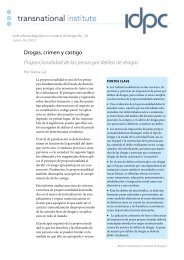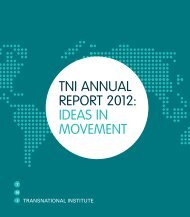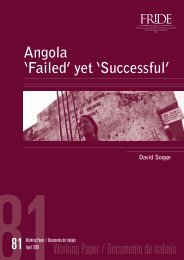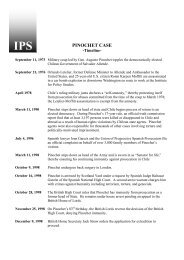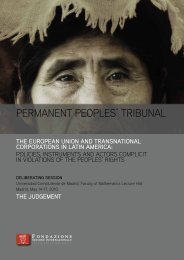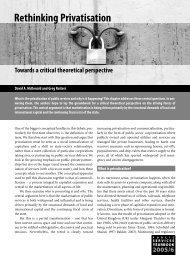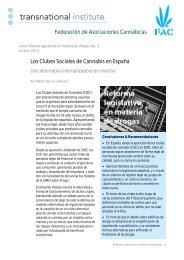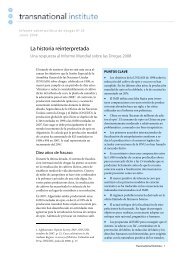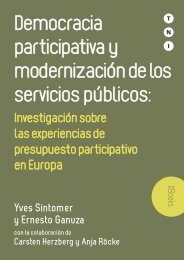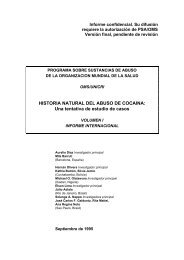New Interregionalism? The EU and East Asia
New Interregionalism? The EU and East Asia
New Interregionalism? The EU and East Asia
Create successful ePaper yourself
Turn your PDF publications into a flip-book with our unique Google optimized e-Paper software.
308 Julie Gilson‘region–to–region dialogue’, or the concept of interregionalism, with referenceto this “sprawling variety”? This article examines how the <strong>EU</strong> utilizesinterregionalism as one mechanism for managing economic <strong>and</strong> political relationswith a growing yet disparate region <strong>and</strong> how, in so doing, it may influence<strong>and</strong> shape the very concept of an <strong>East</strong> <strong>Asia</strong>n region. <strong>The</strong> developmentof the ASEAN (Association of Southeast <strong>Asia</strong>n Nations) Plus Three (APT)process <strong>and</strong> growing intra–regional dynamics have been reinforced by participationin explicitly interregional formats (namely <strong>EU</strong>–ASEAN dialogue <strong>and</strong>the <strong>Asia</strong>–Europe Meeting, ASEM), with the effect that <strong>EU</strong> representativesoften single out the <strong>East</strong> <strong>Asia</strong>n dimension, comprising Southeast <strong>and</strong> Northeast<strong>Asia</strong>. 1<strong>The</strong> fifth <strong>Asia</strong>–Europe Meeting (ASEM) took place in Hanoi in September2004 under the umbrella theme of ‘Further Revitalising <strong>and</strong> Substantiatingthe <strong>Asia</strong>–Europe Partnership’. <strong>The</strong> twenty–five original member states hadgrown to thirty–nine, with the inclusion of the newest members of theASEAN <strong>and</strong> the ten new members of the <strong>EU</strong>, following their accession inMay 2004. Reflecting upon the eight–year history of the interregionalencounter, leaders noted in particular that economic cooperation, fortifiedby the ‘Hanoi Declaration on Closer Economic Partnership’ should becomplemented by the political initiatives enshrined in their ‘Declaration onMultilateralism’: “ASEM Ministers reaffirmed their commitment to multilateralism<strong>and</strong> to a fair <strong>and</strong> just rules–based international order, with a strongUnited Nations at its heart, to resolve international disputes, to promotepositive aspects of globalization, <strong>and</strong> to advance democratization of internationalrelations” (MOFA 2004).Based on the four principles of informality, multi–dimensionality, equalpartnership <strong>and</strong> a high–level focus, ASEM presents the <strong>EU</strong> with a usefulmechanism for managing relations with thirteen different economies,promoting democratic values <strong>and</strong> the pursuit of human rights among stateswhose record has yet to satisfy European dem<strong>and</strong>s, <strong>and</strong> balancing geostrategicinterests in a volatile <strong>and</strong> rapidly changing region. It serves not only as anoverarching framework in which to express a range of themes that arepursued simultaneously in bilateral agreements, but also as the very locus forsuch bilateral encounters. In these ways, <strong>and</strong> as this analysis will demonstrate,ASEM delineates a generic context for interaction.For the participating states of <strong>East</strong> <strong>Asia</strong>, the ASEM process offers a meansof dealing collectively with twenty–five states, provides a first–h<strong>and</strong> examinationof the practices of regional integration <strong>and</strong> establishes a framework inwhich <strong>East</strong> <strong>Asia</strong> can present itself as a regional political <strong>and</strong> economic entity<strong>and</strong> realize the ‘third side’ in a global triangle of regional economic blocs(Pou Serradell 1996, 191; CAEC 1996; Maull et al. 1998, xiv). In these ways,then, ASEM is one of a number of foreign policy tools available to the <strong>EU</strong><strong>and</strong> serves several important functions. Nevertheless, it is not intended as areplacement for other forms of engagement. Indeed, as will be shown, it mayrepresent an historical moment in the building up of a variety of relations.<strong>The</strong> first section of this analysis considers the relevance of interregionalismfor this case study. <strong>The</strong> second section examines the driving forces in the <strong>EU</strong>



